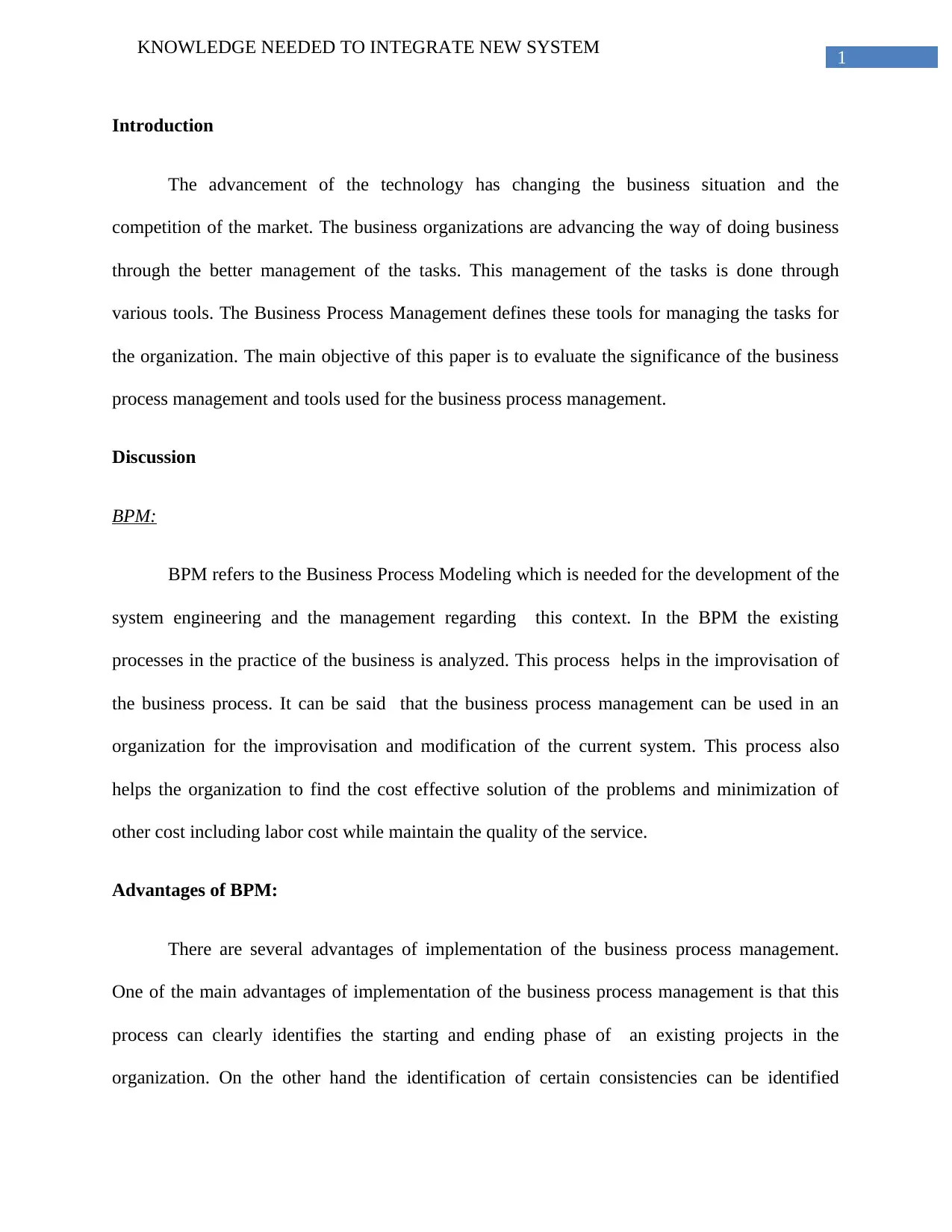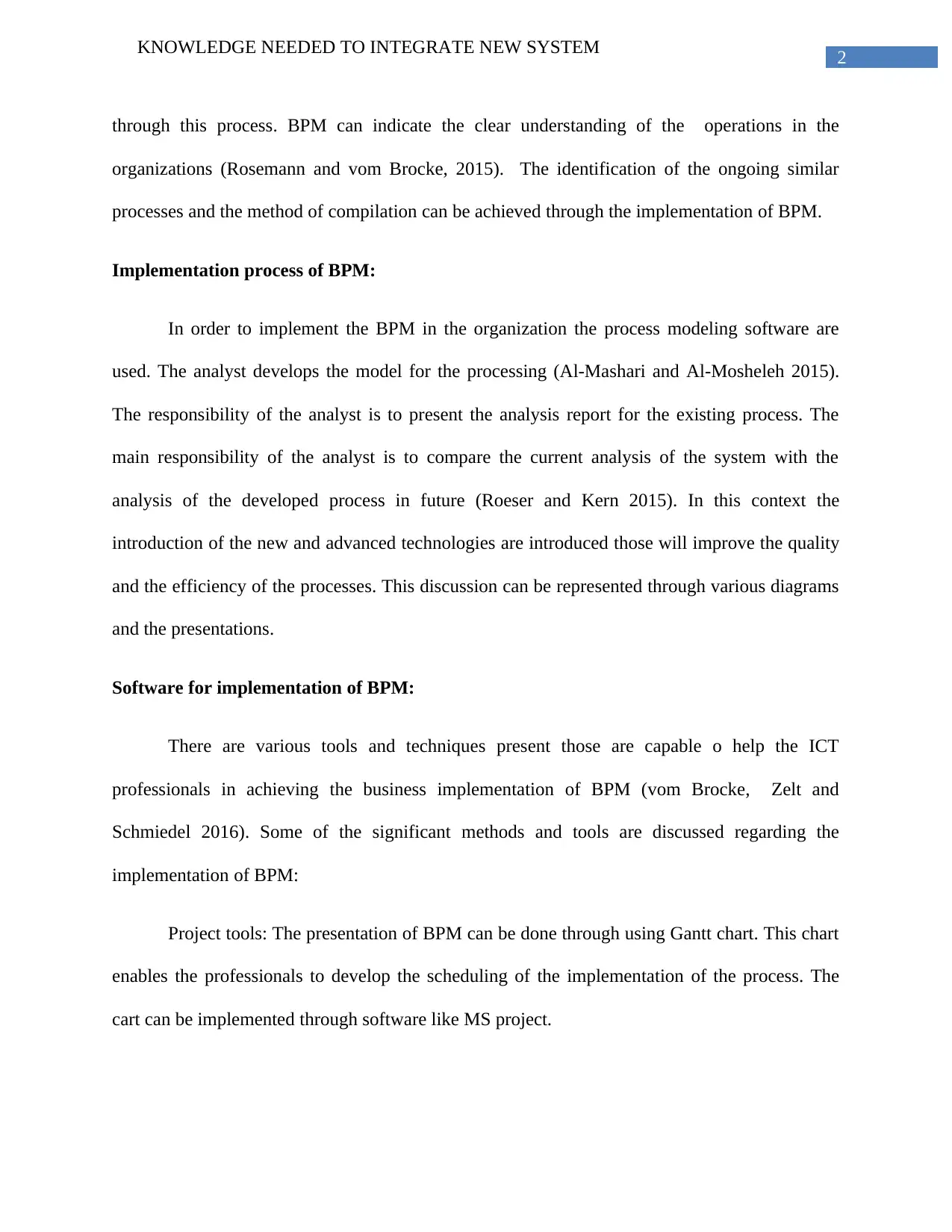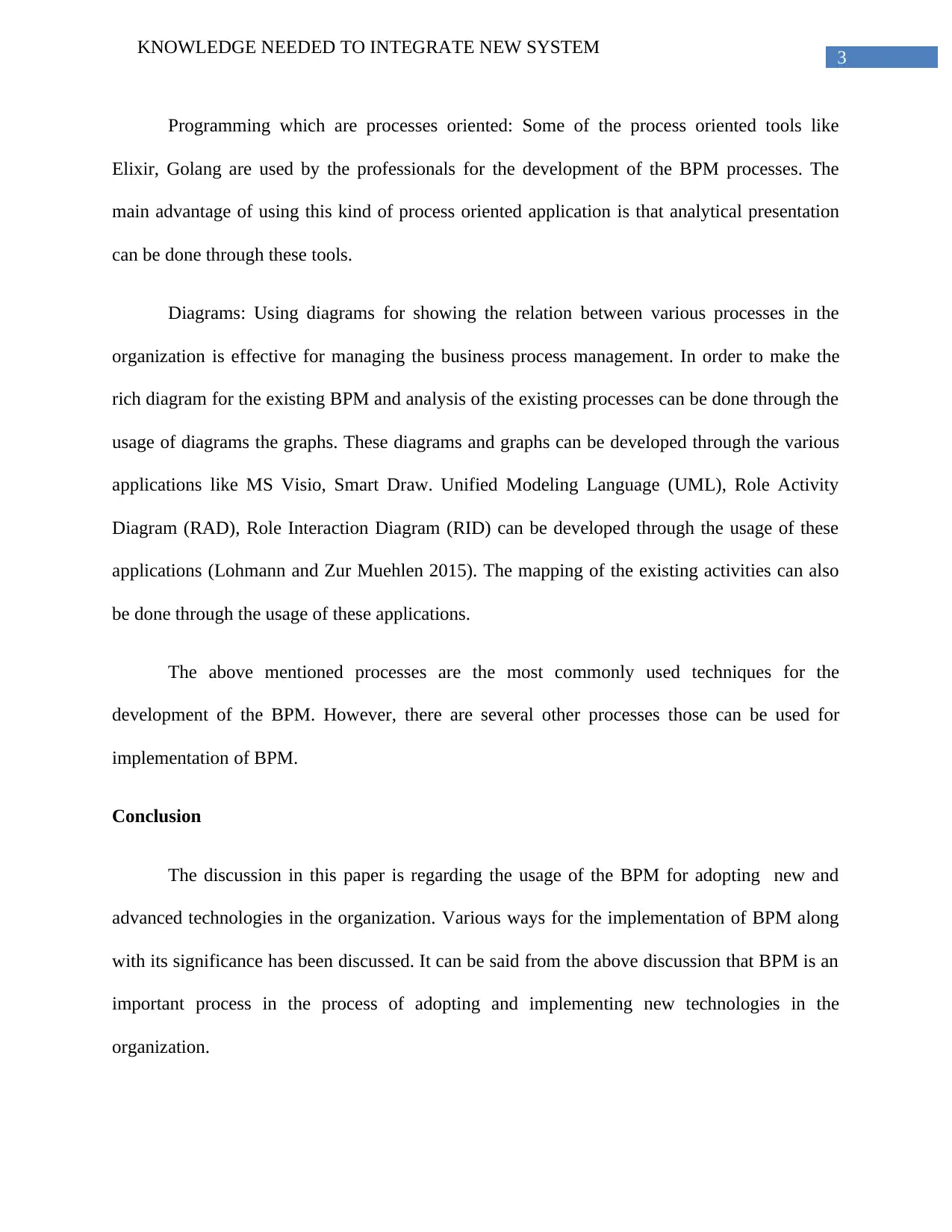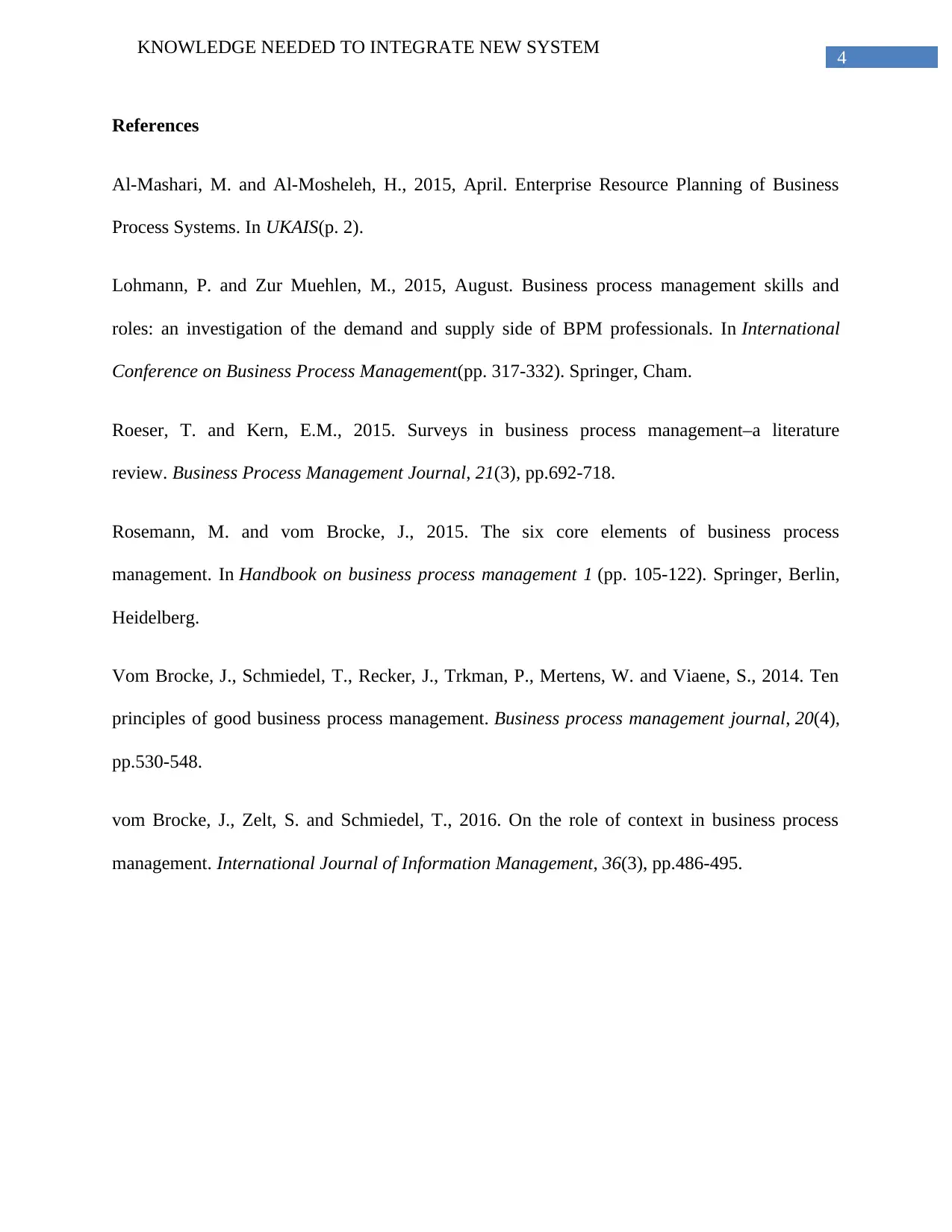Evaluating BPM and Technology Integration: A Comprehensive Report
VerifiedAdded on 2023/06/08
|6
|1083
|351
Report
AI Summary
This report analyzes the significance of Business Process Management (BPM) in the context of technological advancements and market competition. It emphasizes how BPM tools facilitate better task management within organizations. The report discusses the advantages of BPM, such as identifying project phases and process consistencies, leading to improved operational understanding. It outlines the implementation process, including the use of process modeling software, and highlights various tools like project tools (Gantt charts), programming languages (Elixir, Golang), and diagramming software (MS Visio, Smart Draw) for effective BPM. The report also explores the application of UML, RAD, and RID diagrams. Ultimately, the report concludes that BPM is crucial for adopting and implementing new technologies within an organization, providing insights into its implementation and significance, and supporting the integration of new systems.

Running head: KNOWLEDGE NEEDED TO INTEGRATE NEW SYSTEM
KNOWLEDGE NEEDED TO INTEGRATE NEW SYSTEM
Name of the Student:
Name of the University:
Author Note:
KNOWLEDGE NEEDED TO INTEGRATE NEW SYSTEM
Name of the Student:
Name of the University:
Author Note:
Paraphrase This Document
Need a fresh take? Get an instant paraphrase of this document with our AI Paraphraser

1
KNOWLEDGE NEEDED TO INTEGRATE NEW SYSTEM
Introduction
The advancement of the technology has changing the business situation and the
competition of the market. The business organizations are advancing the way of doing business
through the better management of the tasks. This management of the tasks is done through
various tools. The Business Process Management defines these tools for managing the tasks for
the organization. The main objective of this paper is to evaluate the significance of the business
process management and tools used for the business process management.
Discussion
BPM:
BPM refers to the Business Process Modeling which is needed for the development of the
system engineering and the management regarding this context. In the BPM the existing
processes in the practice of the business is analyzed. This process helps in the improvisation of
the business process. It can be said that the business process management can be used in an
organization for the improvisation and modification of the current system. This process also
helps the organization to find the cost effective solution of the problems and minimization of
other cost including labor cost while maintain the quality of the service.
Advantages of BPM:
There are several advantages of implementation of the business process management.
One of the main advantages of implementation of the business process management is that this
process can clearly identifies the starting and ending phase of an existing projects in the
organization. On the other hand the identification of certain consistencies can be identified
KNOWLEDGE NEEDED TO INTEGRATE NEW SYSTEM
Introduction
The advancement of the technology has changing the business situation and the
competition of the market. The business organizations are advancing the way of doing business
through the better management of the tasks. This management of the tasks is done through
various tools. The Business Process Management defines these tools for managing the tasks for
the organization. The main objective of this paper is to evaluate the significance of the business
process management and tools used for the business process management.
Discussion
BPM:
BPM refers to the Business Process Modeling which is needed for the development of the
system engineering and the management regarding this context. In the BPM the existing
processes in the practice of the business is analyzed. This process helps in the improvisation of
the business process. It can be said that the business process management can be used in an
organization for the improvisation and modification of the current system. This process also
helps the organization to find the cost effective solution of the problems and minimization of
other cost including labor cost while maintain the quality of the service.
Advantages of BPM:
There are several advantages of implementation of the business process management.
One of the main advantages of implementation of the business process management is that this
process can clearly identifies the starting and ending phase of an existing projects in the
organization. On the other hand the identification of certain consistencies can be identified

2
KNOWLEDGE NEEDED TO INTEGRATE NEW SYSTEM
through this process. BPM can indicate the clear understanding of the operations in the
organizations (Rosemann and vom Brocke, 2015). The identification of the ongoing similar
processes and the method of compilation can be achieved through the implementation of BPM.
Implementation process of BPM:
In order to implement the BPM in the organization the process modeling software are
used. The analyst develops the model for the processing (Al-Mashari and Al-Mosheleh 2015).
The responsibility of the analyst is to present the analysis report for the existing process. The
main responsibility of the analyst is to compare the current analysis of the system with the
analysis of the developed process in future (Roeser and Kern 2015). In this context the
introduction of the new and advanced technologies are introduced those will improve the quality
and the efficiency of the processes. This discussion can be represented through various diagrams
and the presentations.
Software for implementation of BPM:
There are various tools and techniques present those are capable o help the ICT
professionals in achieving the business implementation of BPM (vom Brocke, Zelt and
Schmiedel 2016). Some of the significant methods and tools are discussed regarding the
implementation of BPM:
Project tools: The presentation of BPM can be done through using Gantt chart. This chart
enables the professionals to develop the scheduling of the implementation of the process. The
cart can be implemented through software like MS project.
KNOWLEDGE NEEDED TO INTEGRATE NEW SYSTEM
through this process. BPM can indicate the clear understanding of the operations in the
organizations (Rosemann and vom Brocke, 2015). The identification of the ongoing similar
processes and the method of compilation can be achieved through the implementation of BPM.
Implementation process of BPM:
In order to implement the BPM in the organization the process modeling software are
used. The analyst develops the model for the processing (Al-Mashari and Al-Mosheleh 2015).
The responsibility of the analyst is to present the analysis report for the existing process. The
main responsibility of the analyst is to compare the current analysis of the system with the
analysis of the developed process in future (Roeser and Kern 2015). In this context the
introduction of the new and advanced technologies are introduced those will improve the quality
and the efficiency of the processes. This discussion can be represented through various diagrams
and the presentations.
Software for implementation of BPM:
There are various tools and techniques present those are capable o help the ICT
professionals in achieving the business implementation of BPM (vom Brocke, Zelt and
Schmiedel 2016). Some of the significant methods and tools are discussed regarding the
implementation of BPM:
Project tools: The presentation of BPM can be done through using Gantt chart. This chart
enables the professionals to develop the scheduling of the implementation of the process. The
cart can be implemented through software like MS project.
⊘ This is a preview!⊘
Do you want full access?
Subscribe today to unlock all pages.

Trusted by 1+ million students worldwide

3
KNOWLEDGE NEEDED TO INTEGRATE NEW SYSTEM
Programming which are processes oriented: Some of the process oriented tools like
Elixir, Golang are used by the professionals for the development of the BPM processes. The
main advantage of using this kind of process oriented application is that analytical presentation
can be done through these tools.
Diagrams: Using diagrams for showing the relation between various processes in the
organization is effective for managing the business process management. In order to make the
rich diagram for the existing BPM and analysis of the existing processes can be done through the
usage of diagrams the graphs. These diagrams and graphs can be developed through the various
applications like MS Visio, Smart Draw. Unified Modeling Language (UML), Role Activity
Diagram (RAD), Role Interaction Diagram (RID) can be developed through the usage of these
applications (Lohmann and Zur Muehlen 2015). The mapping of the existing activities can also
be done through the usage of these applications.
The above mentioned processes are the most commonly used techniques for the
development of the BPM. However, there are several other processes those can be used for
implementation of BPM.
Conclusion
The discussion in this paper is regarding the usage of the BPM for adopting new and
advanced technologies in the organization. Various ways for the implementation of BPM along
with its significance has been discussed. It can be said from the above discussion that BPM is an
important process in the process of adopting and implementing new technologies in the
organization.
KNOWLEDGE NEEDED TO INTEGRATE NEW SYSTEM
Programming which are processes oriented: Some of the process oriented tools like
Elixir, Golang are used by the professionals for the development of the BPM processes. The
main advantage of using this kind of process oriented application is that analytical presentation
can be done through these tools.
Diagrams: Using diagrams for showing the relation between various processes in the
organization is effective for managing the business process management. In order to make the
rich diagram for the existing BPM and analysis of the existing processes can be done through the
usage of diagrams the graphs. These diagrams and graphs can be developed through the various
applications like MS Visio, Smart Draw. Unified Modeling Language (UML), Role Activity
Diagram (RAD), Role Interaction Diagram (RID) can be developed through the usage of these
applications (Lohmann and Zur Muehlen 2015). The mapping of the existing activities can also
be done through the usage of these applications.
The above mentioned processes are the most commonly used techniques for the
development of the BPM. However, there are several other processes those can be used for
implementation of BPM.
Conclusion
The discussion in this paper is regarding the usage of the BPM for adopting new and
advanced technologies in the organization. Various ways for the implementation of BPM along
with its significance has been discussed. It can be said from the above discussion that BPM is an
important process in the process of adopting and implementing new technologies in the
organization.
Paraphrase This Document
Need a fresh take? Get an instant paraphrase of this document with our AI Paraphraser

4
KNOWLEDGE NEEDED TO INTEGRATE NEW SYSTEM
References
Al-Mashari, M. and Al-Mosheleh, H., 2015, April. Enterprise Resource Planning of Business
Process Systems. In UKAIS(p. 2).
Lohmann, P. and Zur Muehlen, M., 2015, August. Business process management skills and
roles: an investigation of the demand and supply side of BPM professionals. In International
Conference on Business Process Management(pp. 317-332). Springer, Cham.
Roeser, T. and Kern, E.M., 2015. Surveys in business process management–a literature
review. Business Process Management Journal, 21(3), pp.692-718.
Rosemann, M. and vom Brocke, J., 2015. The six core elements of business process
management. In Handbook on business process management 1 (pp. 105-122). Springer, Berlin,
Heidelberg.
Vom Brocke, J., Schmiedel, T., Recker, J., Trkman, P., Mertens, W. and Viaene, S., 2014. Ten
principles of good business process management. Business process management journal, 20(4),
pp.530-548.
vom Brocke, J., Zelt, S. and Schmiedel, T., 2016. On the role of context in business process
management. International Journal of Information Management, 36(3), pp.486-495.
KNOWLEDGE NEEDED TO INTEGRATE NEW SYSTEM
References
Al-Mashari, M. and Al-Mosheleh, H., 2015, April. Enterprise Resource Planning of Business
Process Systems. In UKAIS(p. 2).
Lohmann, P. and Zur Muehlen, M., 2015, August. Business process management skills and
roles: an investigation of the demand and supply side of BPM professionals. In International
Conference on Business Process Management(pp. 317-332). Springer, Cham.
Roeser, T. and Kern, E.M., 2015. Surveys in business process management–a literature
review. Business Process Management Journal, 21(3), pp.692-718.
Rosemann, M. and vom Brocke, J., 2015. The six core elements of business process
management. In Handbook on business process management 1 (pp. 105-122). Springer, Berlin,
Heidelberg.
Vom Brocke, J., Schmiedel, T., Recker, J., Trkman, P., Mertens, W. and Viaene, S., 2014. Ten
principles of good business process management. Business process management journal, 20(4),
pp.530-548.
vom Brocke, J., Zelt, S. and Schmiedel, T., 2016. On the role of context in business process
management. International Journal of Information Management, 36(3), pp.486-495.

5
KNOWLEDGE NEEDED TO INTEGRATE NEW SYSTEM
KNOWLEDGE NEEDED TO INTEGRATE NEW SYSTEM
⊘ This is a preview!⊘
Do you want full access?
Subscribe today to unlock all pages.

Trusted by 1+ million students worldwide
1 out of 6
Related Documents
Your All-in-One AI-Powered Toolkit for Academic Success.
+13062052269
info@desklib.com
Available 24*7 on WhatsApp / Email
![[object Object]](/_next/static/media/star-bottom.7253800d.svg)
Unlock your academic potential
Copyright © 2020–2025 A2Z Services. All Rights Reserved. Developed and managed by ZUCOL.





